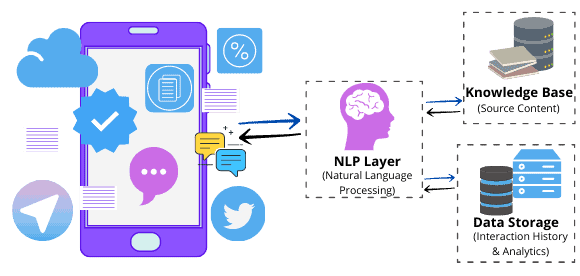1. 智能聊天机器人的定义
聊天机器人(Chatbot)是一种基于人工智能技术的软件,能够与用户进行自然语言对话。它的目标是尽可能模拟人类交流方式,通过文本或语音与用户互动。最早的聊天机器人之一是ELIZA,它通过预设规则识别关键词并生成回应,模仿心理治疗师的对话方式。
现代智能聊天机器人则依赖AI和机器学习技术,能识别用户意图并生成更自然、个性化的回答。目标是让用户难以分辨对话对象是机器还是真人。
2. 聊天机器人的分类
聊天机器人根据其智能程度和技术实现,主要分为以下两类:
✅ 规则驱动型(Rule-Based Chatbot)
- 依赖预设规则和关键词匹配
- 适合处理结构化、固定模式的问题
- 优点:开发简单,响应速度快
- 缺点:无法处理复杂或模糊的用户输入
✅ 自学习型(Self-Learning Chatbot)
- 基于AI和机器学习技术,具备自我学习能力
- 可分为两种子类型:
2.1 检索型(Retrieval-Based Chatbot)
- 根据用户输入匹配预设问题,返回预设答案
- 使用启发式算法进行意图识别
- 示例:

2.2 生成型(Generative Chatbot)
- 不依赖预设答案,通过模型生成新的回复
- 需要大量训练数据和复杂的NLP模型
- 更接近自然语言交互,适合开放性对话
- 示例:

3. 聊天机器人架构解析
聊天机器人由多个模块协同工作,形成完整的对话流程。其典型架构如下:

3.1 语言识别模块(Language Identification)
- 判断用户输入语言,为后续处理提供基础
- 在多语言场景中尤为重要,避免语义混淆
3.2 意图识别模块(Intent Classification)
- 识别用户意图,是对话理解的核心
- 常用技术包括关键词匹配、贝叶斯分类、深度学习模型等
3.3 动作选择模块(Action Selection)
- 根据识别结果决定下一步动作
- 例如:回复预设答案、调用API、继续提问等
3.4 动作执行模块(Action Handling)
- 执行选定动作,可能涉及调用外部服务或数据库
- 不同平台(如网站、Messenger)执行方式不同
4. 聊天机器人核心技术
4.1 分类方法
✅ 模式匹配(Pattern Matching)
- 使用预设规则匹配用户输入
- 适用于简单场景,如FAQ类问答
| 序号 | 用户输入 | 匹配模式 |
|---|---|---|
| 1 | Hi! I'm in need of help. | *help* |
| 2 | Hello, I have a problem. | *problem* |
✅ 自然语言理解(NLU)
- 包括实体识别、上下文理解、意图识别
- 示例:

✅ 自然语言处理(NLP)
- 用于理解和生成自然语言
- 主要流程包括:
- ✅ Tokenization:将文本拆分为词语单元
- ✅ Normalization:标准化拼写、格式
- ✅ Entity Recognition:识别关键词、实体
- ✅ Dependency Parsing:分析语法结构
- ✅ Sentiment Analysis:判断用户情绪

4.2 知识管理(Knowledge Management)
- 机器人需具备基础知识库,才能有效回答问题
- 常见方式包括:
- ✅ 调用API获取实时数据
- ✅ 查询本地数据库
- ✅ 使用预训练知识图谱
4.3 回复生成(Response Generation)
- 回复需自然、上下文相关
- 常用方法:
- ✅ 检索型:从已有答案中挑选
- ✅ 生成型:通过模型生成新内容
5. 构建一个聊天机器人的步骤
✅ 明确目标
- 是做客服助手?还是娱乐型机器人?
- 明确使用场景和目标用户
✅ 选择通信渠道
- Web、App、Messenger、Slack、微信等
- 根据目标用户活跃平台选择
✅ 选择技术栈
- 开发语言:Python、Java、Node.js 等
- 框架/库:Rasa、Dialogflow、ChatterBot、Hugging Face Transformers 等
✅ 设计对话流程
- 定义用户旅程(User Journey)
- 编写“Happy Path”和异常处理逻辑
✅ 训练模型
- 使用历史对话数据训练意图识别和回复生成模型
- 可用公开数据集如:
- NPS Chat Corpus
- Question-Answer Dataset
- ChatterBot Corpus
✅ 测试机器人
- 模拟多种用户输入场景
- 确保机器人在各种边界情况下也能正常响应
✅ 部署上线
- 集成到目标平台(Web、App、IM等)
- 配置API接口、数据库连接
- 监控运行状态,持续优化
6. 总结
本文介绍了智能聊天机器人的基本概念、分类、核心技术与构建流程。无论是用于客服、教育还是娱乐,构建一个高效、自然的聊天机器人都需要综合运用AI、NLP、知识图谱等技术。
✅ 关键点总结:
- 检索型机器人适合结构化场景,开发简单
- 生成型机器人更智能,但依赖高质量训练数据
- 架构设计要模块化,便于扩展和维护
- 意图识别和上下文理解是对话流畅的关键
- 实际部署后持续优化至关重要
如果你正在考虑构建一个智能客服机器人,或想为你的产品添加一个虚拟助手,不妨从一个规则型机器人起步,逐步引入AI能力,实现更高级的功能。